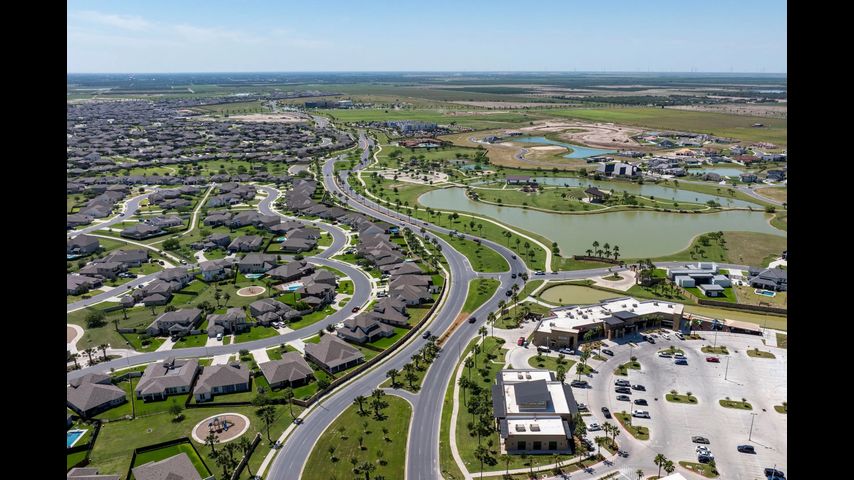As the Rio Grande runs dry, South Texas leaders look to new water supplies to sustain growth
"As the Rio Grande runs dry, South Texas leaders look to new water supplies to sustain growth" was first published by The Texas Tribune, a nonprofit, nonpartisan media organization that informs Texans — and engages with them — about public policy, politics, government and statewide issues.
Subscribe to The Y’all — a weekly dispatch about the people, places and policies defining Texas, produced by Texas Tribune journalists living in communities across the state.
This article is part of Running Out, an occasional series about Texas’ water crisis. Read more stories about the threats facing Texas’ water supply here.
MISSION — More than 100 years ago, developers lured farmers to the Rio Grande Valley by marketing the “Magic Valley,” a tropical place of plentiful water where crops grow year-round.
The veracity of that marketing was questionable.
For one, the state’s most southern region is not a valley, but a delta. Secondly, periodic drought affected the area even then.
Regardless, farmers came from all over the country, developing the area into one of the largest producers of citrus in the country. Farmers also grew various vegetables, sugarcane and cotton, utilizing the water from the Rio Grande, one of the nation’s most iconic rivers.
Cities such as McAllen, Mission and Weslaco sprang up, using the irrigation water to carry the municipal water to their treatment facilities, increasing demand on the river, even when drought existed.
[Texas is running out of water. Here’s why and what state leaders plan to do about it.]
The tension between water supply and demand has been an issue for decades. And now, city and county leaders throughout the Valley believe the problem has come to a head. Water levels at the two international reservoirs that store the river water supply for South Texas reached record lows last year, and water levels continue to hover around 20%.
At the same time the Rio Grande runs dry, the South Texas population is rapidly increasing. Officials wary of slowing growth are seeking alternative water supplies, including groundwater and new ways to recycle water. But those take time, and if solutions aren’t found fast, the region’s growth and economic prosperity could be stunted.
“When we talk about the needs for water, they're real needs and we do have a problem," said Hidalgo County Judge Richard F. Cortez. “I think that we all want to solve the problem and do the best that we can with the situation, and I see a lot of us working together to try to reach that balance between the needs of municipalities and the needs of agriculture."
South Texas’ water struggles mirror much of the state. Texas’ water supply is under duress from a growing population and increased industry, climate change and outdated infrastructure that loses billions of gallons of water annually.
/https://static.texastribune.org/media/files/83166b88a6cec3b6e6b23662a47a95e6/0512%20Rio%20Runs%20Dry%20MG%20TT%2043.JPG)
The Rio Grande Valley region would not have enough water to meet demand for cities, farming, and power generation if the state were struck by a historic drought, similar to the one in the 1950s, according to state data. And demand for municipal water is only expected to increase over the next several decades, with no increase in supply on the horizon.
State lawmakers have pledged to save the state’s water. In Austin, they are debating a multi-billion-dollar package that would help cities and other local water agencies repair broken pipes and find ways to create new water, such as a project under consideration here that would recycle drain water.
The region will need as much help as it can get as it faces the daunting task of diversifying its water supply, using less of the water from its namesake river, and turning to whatever water is trapped underground.
The Valley’s farmers and ranchers have for decades warned of disaster. Entire agricultural industries have collapsed due to the lack of water in the region.
More recently, they have led the charge in demanding that Mexico send water to the region, as required under a 1944 treaty. While their efforts appear to have paid off — the U.S. recently announced an update to that treaty — data suggests extreme heat has siphoned the Rio Grande, as well.
Areas along the Rio Grande and much of Northeastern Mexico are in a particularly dry period, said John Nielsen-Gammon, Texas State Climatologist and director of the Southern Regional Climate Center.
The center monitors drought, tracks water levels and water restrictions across the state.
Hotter days mean that water evaporates faster, which leads to more water lost from the surface of lakes, rivers and reservoirs.
Perhaps few in the region heeded the farmers’ warning because there has been little threat to cities and their rapid growth. Until now.
Between 2010 and 2020, the lower valley added more than 100,000 people. The McAllen area’s population grew by about 12%, slightly slower than the statewide average of 15% during that decade.
/https://static.texastribune.org/media/files/9bdfed80e318f23cc4993fd515bfa12e/0512%20Rio%20Runs%20Dry%20MG%20TT%2038.JPG)
Nick Rhodes built houses for many of them. He’s the CEO of Rhodes Enterprises, the largest homebuilder in the Valley. His company faces a new challenge, securing enough water rights necessary to build homes for all the people moving to South Texas.
"We've developed subdivisions in Mission, McAllen, Edinburg, San Juan, Weslaco, Harlingen, Brownsville,” he said. “Water is a concern everywhere.”
Development hasn’t stopped but, absent a long-term solution, growth could slow and lead to a rise in home prices.
"Home prices would, for sure, go up locally, and I think it would deter new job growth," Rhodes said. "If you can't build housing, then you're not going to attract that job creation — factories, new companies, things like that.”
Water rights help the state manage surface water like the Rio Grande and other rivers and lakes. They are granted by the state to farmers, cities, businesses, irrigation districts, and other entities.
Cities and water districts in the region have also taken steps to conserve what they have. Many began issuing water restrictions in 2023 and, in September, they joined Hidalgo County to sign onto a uniform drought contingency plan.
The purpose is to have uniform triggers among them so that residents can understand the various drought conservation stages.
If water levels drop drastically, those restrictions could affect building permits.
“We're not at that point yet, but it's definitely a major concern,” Rhodes said. “If something doesn't change for X number of years, we're going to run out of water.”
Last year, Mission city leaders considered issuing a moratorium on new developments larger than five acres due to water scarcity. The city council didn’t go through with it, but in April 2024, they put in place a fee to developers who did not obtain additional rights to water from the river.
Like Mission, many cities — or the water supply company that provides water to that area — either require developers to obtain water rights or charge the developer a fee so that the city may obtain those rights.
/https://static.texastribune.org/media/files/964575ac48b2496c5c598d2eb64cefba/0512%20Rio%20Runs%20Dry%20MG%20TT%2048.JPG)
But every city and water corporation is different and the fees they choose to impose can impact where growth happens.
The west side of Hidalgo County lacks the robust residential and commercial development that has been facilitated in other parts of the county. It’s evident driving down the highway. While the drive eastward to Weslaco is busy with businesses lining the frontage road, the drive west to Sullivan City is less so, with wide open spaces lining the route.
Rhodes said that’s due to the water acquisition fees charged by the water supplier to the area, the Agua Special Utility District, which are higher than what you might find in McAllen or Edinburg.
Agua charges a fee of $1,175.00 per home while the North Alamo Water Supply Corporation, which provides water to parts of Edinburg, eastern Hidalgo County, Willacy County, and northwestern Cameron County, charges fees that range from $225 to $850.
“In some of these water districts in Cameron County, the fees have gotten so high, stuff actually won't develop,” Rhodes said.
Higher acquisition fees can be driven by a shortage of water or the cost to treat the available supply. It can also help keep water rates for the eventual homeowner low. Regardless of the reason, it is still impacting growth.
The Agua water district reported that drought conditions led to a decrease in growth in 2024.
“Although water revenue is variable and depends on climatic conditions, the District has seen a decrease in year-to-year revenue due to lower consumption and slower growth in new accounts, resulting from drought conditions,” Roberto J. Salinas, the general manager, wrote in a letter accompanying the district’s 2025 budget.
This concern over a greater slowdown in growth comes at a time when the Valley and northern Mexico are collectively trying to attract new businesses into the area.
Last year, regional partners launched an initiative to rebrand the area as the “RioPlex” to highlight the region's assets, including four seaports, seven airports, 13 international bridges, more than 100,000 university students and approximately 2.8 to 3.5 million residents in the Valley and northern Tamaulipas.
This marketing strategy is part of a larger effort to bring higher-paying jobs to the Valley to help lift residents out of poverty.
“We've done a lot to really try to bring investment to this area,” Cortez said.
But as officials hope to draw high-tech jobs and incentivize residents to stay in the area, they must also grapple with how to ensure they have enough water for them in the years to come.
/https://static.texastribune.org/media/files/6d701b488260a63a6a5fa13f7c418198/0512%20Rio%20Runs%20Dry%20MG%20TT%2055.jpg)
About 90% of the region, including the agriculture industry and municipalities, rely on surface water from the Rio. It’s cheap compared to the cost it takes to treat brackish groundwater, and it’s allowed residents to enjoy relatively low water bills.
But if the Valley is going to obtain enough water to sustain residential and commercial growth, people are going to have to accept they’ll have to pay a little more, Rhodes said.
“Everyone is addicted to this ultra-cheap river water,” Rhodes said. “People need to understand the solution’s probably groundwater and that's going to lead to everyone having to pay a little bit more for their water bill.”
Water from the river, along with other bodies of water on the Earth’s surface like lakes and streams, is what is known as surface water. Groundwater, meanwhile, is pumped from underground aquifers and tends to have a higher concentration of salts and minerals than surface water, which requires expensive treatment.
[Want to understand Texas’ water crisis? Start with the guide to water terms.]
Like Rhodes, Cortez said the region will have to come to terms with paying more for water.
“Water is going to be more expensive,” Cortez said. “We need to get together as a region to solve this regional water problem and use critical mass to reduce the cost for everybody.”
Rhodes is hopeful that city and county officials will start pushing for projects that will make use of the groundwater available.
“People have been talking about groundwater for 10-20 years, and then it'll start raining again, and the reservoirs will go back up, and then people don't want to talk about it anymore,” Rhodes said. “We're hoping this is a big enough wake up call that even if it does start raining and the reservoirs go back up, we've got to start addressing these issues as a community.”
While cities like McAllen and Brownsville are hoping to obtain state funding to build more desalination plants that will treat brackish groundwater, there are other efforts.
A project by the Hidalgo County Drainage District surpassed a major hurdle toward becoming a reality.
The project, called the Delta Regional Water Management Project, involves capturing excess stormwater that would otherwise be lost to the gulf and turning it into a new water source for drinking water. Diverting this water would alleviate flooding in the area.
The county purchased a site for the first treatment facility in northern Hidalgo County with plans underway to open three more.
“With those four plants, we would provide about 18 million gallons of water on a daily basis, even in a drought situation,” Fuentes said, which would be about 66 acre-feet of water per day, enough water for 73,200 people.
/https://static.texastribune.org/media/files/7b6a55318d99497244a4535aeb4d4ad8/0425%20Rio%20Runs%20Dry%20MG%20TT%2018.JPG)
Paying for the project has been a challenge. It didn’t qualify for funding under traditional state funding models. Funding programs through the state takes into consideration the number of residential users a water supply company has for water sales.
But the county drainage district won’t sell water to thousands of homes, they’ll be a wholesale water provider selling to cities or water supply companies. Those water supply companies will then provide water to residents.
To address the funding issue, Fuentes and the county worked with state legislators on a bill that would create a new way of considering projects like theirs. Senate Bill 1967 allows drainage districts to qualify for funding even if they don’t have historical data about water use and even if they don’t provide retail water service directly to consumers.
The bill received approval from state lawmakers earlier this month.
"We're trying to find a solution that will help everybody around here," Fuentes said.
The cities of McAllen and Brownsville as well as the North Alamo Water Supply Corporation, have groundwater projects that they’re hoping to obtain funding for through the state, a sign that leaders are serious about moving away using the river as the sole water resource for almost the entire region.
Fuentes views projects like the Delta project as the golden parachute that the Valley needs to sustain their growth, even if rainfall suddenly provides significant gains to the reservoirs and calms fears for a few months.
"This is going to happen again, this is going to happen in the next year, two years," Fuentes said. "Quite honestly, we thought we were answering a problem we were going to have 50 years from now."
/https://static.texastribune.org/media/files/5169fac24b712bd6677785c5ef542ff0/0425%20Rio%20Runs%20Dry%20MG%20TT%2024.JPG)
Reporting in the Rio Grande Valley is supported in part by the Methodist Healthcare Ministries of South Texas, Inc.
First round of TribFest speakers announced! Pulitzer Prize-winning columnist Maureen Dowd; U.S. Rep. Tony Gonzales, R-San Antonio; Fort Worth Mayor Mattie Parker; U.S. Sen. Adam Schiff, D-California; and U.S. Rep. Jasmine Crockett, D-Dallas are taking the stage Nov. 13–15 in Austin. Get your tickets today!
This article originally appeared in The Texas Tribune at https://www.texastribune.org/2025/05/15/texas-water-rio-grande-valley-drought/.
The Texas Tribune is a member-supported, nonpartisan newsroom informing and engaging Texans on state politics and policy. Learn more at texastribune.org.





